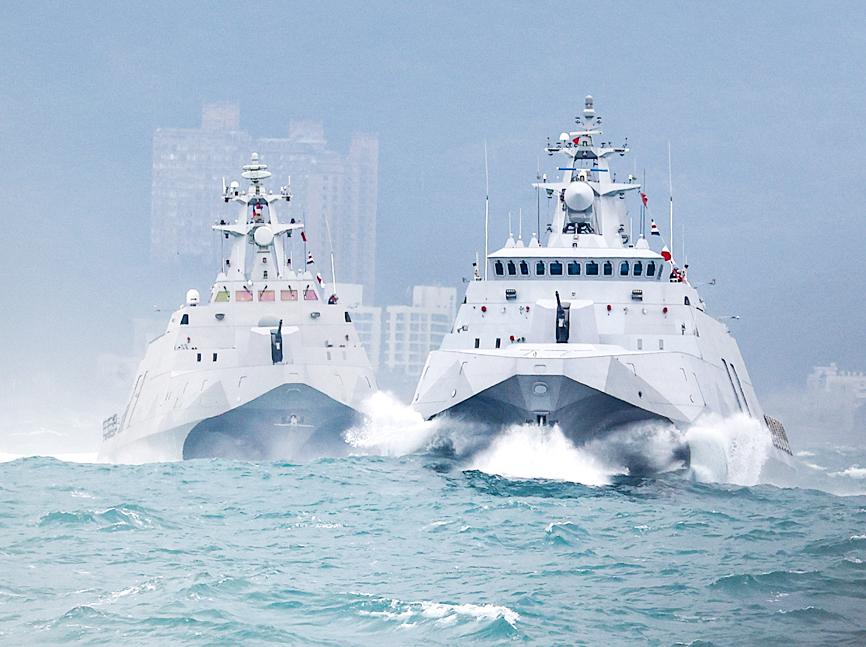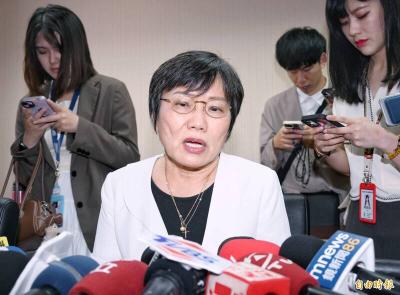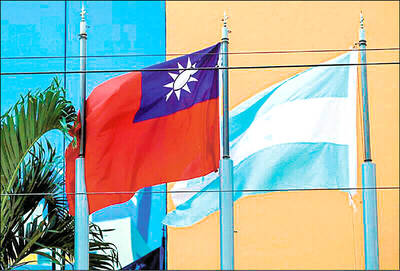The military exercises that Beijing started last week show that Taiwan cannot rely only on asymmetric warfare to deter a Chinese attack, but rather needs to strike a balance between the deployment of military weapons and the development of strategies and tactics to deal with different types of warfare, military experts said.
The Chinese People’s Liberation Army (PLA) launched the exercises around Taiwan on Thursday last week in response to a 19-hour visit by US House of Representatives Speaker Nancy Pelosi to the nation.
During the drills, China fired 11 Dongfeng short-range ballistic missiles into the waters off Taiwan, while warships and fighter jets maneuvered around the nation and crossed the median line of the Taiwan Strait.

Photo: CNA
Taiwan’s navy has focused on the development of small ships such as Tuo Chiang-class corvettes.
However, when the navy monitored Chinese military movements at close range during the exercises, it became apparent that the tonnage of the vessels was much smaller than that of Chinese ships, which triggered discussions on asymmetric warfare strategies.
Lin Ying-yu (林穎佑), an assistant professor in Tamkang University’s Graduate Institute of International Affairs and Strategic Studies, on Monday said the drills demonstrate that Taiwan’s armed forces need to adjust their buildup.
For instance, if the PLA continues to use vessels and aircraft to pressure Taiwan, the navy would need medium and large-tonnage ships to effectively counter Chinese ships, and secure Taiwan’s sea power and lines of communication at sea, while simultaneously developing asymmetric combat capabilities, Lin said.
Separately, former navy lieutenant commander Lu Li-shih (呂禮詩) said Taiwan’s long-term development of small ships such as the corvettes could put naval troops at a disadvantage in a potential combat with larger Chinese vessels.
The navy should build ships that are heavier than 4,000 tonnes, he said.
When China conducted “gray-zone” operations against Taiwan during the drills, the navy was barely able to respond, Lu said, adding that the nation must develop new military methods and avoid adopting a “one-on-one” surveillance war of attrition approach.
However, Taiwan should not return to its old way of thinking, which focused on building up large-scale weapons systems or adopting asymmetric operations, but rather adopt a balanced strategy to deal with different forms of warfare, Lu said.
China’s intensive live-fire military exercises around Taiwan last week provided an excellent opportunity to review the nation’s military strategy and defensive tactics, said Shen Ming-shih (沈明室), director of the Division of National Security Research at the Institute for National Defense and Security Research.
Russia’s war on Ukraine has encouraged Taiwan to believe that urban guerrilla warfare is a feasible combat approach, Shen said.
However, the PLA recognizes that urban fighting could result in a large number of casualties, therefore adopting a blockade and encirclement strategy against Taiwan, as practiced during the drills, he said.
In response to claims that one of the objectives of the Chinese drills was to shatter a tacit mutual understanding that both sides only conduct drills on their side of the median line, Shen offered a different opinion.
A flight path map for PLA aircraft released by Taiwan’s air force showed that Chinese warplanes flew “back and forth” across the median line, he said.
This shows that although China does not recognize the median line, it remains concerned about possible military countermeasures by Taiwan.
Separately, Ministry of National Defense Operations and Planning Division head Yeh Gou-huei (葉國輝) told a news conference that asymmetric operations should not only involve building weapon platforms, but also evolving different strategic and tactical approaches.

Chinese Nationalist Party (KMT) Chairman Eric Chu (朱立倫), spokeswoman Yang Chih-yu (楊智伃) and Legislator Hsieh Lung-chieh (謝龍介) would be summoned by police for questioning for leading an illegal assembly on Thursday evening last week, Minister of the Interior Liu Shyh-fang (劉世芳) said today. The three KMT officials led an assembly outside the Taipei City Prosecutors’ Office, a restricted area where public assembly is not allowed, protesting the questioning of several KMT staff and searches of KMT headquarters and offices in a recall petition forgery case. Chu, Yang and Hsieh are all suspected of contravening the Assembly and Parade Act (集會遊行法) by holding

PRAISE: Japanese visitor Takashi Kubota said the Taiwanese temple architecture images showcased in the AI Art Gallery were the most impressive displays he saw Taiwan does not have an official pavilion at the World Expo in Osaka, Japan, because of its diplomatic predicament, but the government-backed Tech World pavilion is drawing interest with its unique recreations of works by Taiwanese artists. The pavilion features an artificial intelligence (AI)-based art gallery showcasing works of famous Taiwanese artists from the Japanese colonial period using innovative technologies. Among its main simulated displays are Eastern gouache paintings by Chen Chin (陳進), Lin Yu-shan (林玉山) and Kuo Hsueh-hu (郭雪湖), who were the three young Taiwanese painters selected for the East Asian Painting exhibition in 1927. Gouache is a water-based

Taiwan would welcome the return of Honduras as a diplomatic ally if its next president decides to make such a move, Minister of Foreign Affairs Lin Chia-lung (林佳龍) said yesterday. “Of course, we would welcome Honduras if they want to restore diplomatic ties with Taiwan after their elections,” Lin said at a meeting of the legislature’s Foreign Affairs and National Defense Committee, when asked to comment on statements made by two of the three Honduran presidential candidates during the presidential campaign in the Central American country. Taiwan is paying close attention to the region as a whole in the wake of a

OFF-TARGET: More than 30,000 participants were expected to take part in the Games next month, but only 6,550 foreign and 19,400 Taiwanese athletes have registered Taipei city councilors yesterday blasted the organizers of next month’s World Masters Games over sudden timetable and venue changes, which they said have caused thousands of participants to back out of the international sporting event, among other organizational issues. They also cited visa delays and political interference by China as reasons many foreign athletes are requesting refunds for the event, to be held from May 17 to 30. Jointly organized by the Taipei and New Taipei City governments, the games have been rocked by numerous controversies since preparations began in 2020. Taipei City Councilor Lin Yen-feng (林延鳳) said yesterday that new measures by